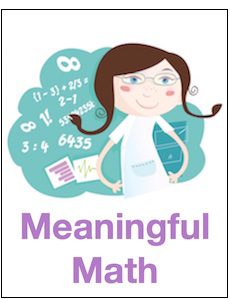Do My Classroom Rules Help or Hurt Learning?
A MiddleWeb Blog

I’m not sure why that annoys me, but it does. Often I’m silently thinking, instead of asking for extra credit, why don’t you do the assignments that have already been assigned that you haven’t done yet?
Changing my Mind
Recently I wanted students to look at two different learning platforms, IXL and Delta Math, and give me some honest feedback (I wrote about the results here).
Well, since I was asking for their help, I thought I would offer them bonus points in return; they had recently asked for an opportunity to earn “extra credit.” I gave them five points for working a few assignments on both platforms and giving me their honest opinion.
You would have thought I was giving away a million dollars. The assignment was optional, but every student did the assignment and gave me good, honest evaluations. The bonus points turned out to be very effective motivators.
I started thinking, if this works, then why not? It suddenly dawned me that by sticking to an old and mostly unfounded bias against bonus points I was making my job harder and not listening to what my students were telling me.
Over time I had created a self-imposed rule against giving extra credit or bonus assignments. However, once I decided to make an exception, it actually worked well. This made me wonder if I had other practices or self-imposed rules there were not helpful or even worse, harmful.
In my mind, classroom rules and teacher practices should exist in order to encourage and facilitate learning – not something I do “just because.” I realized I needed to revisit my other classroom practices to see if they had merit or were just something that I had gotten in the habit of doing.
Revisiting Other Class Practices
Retakes on Tests
Until recently, I have resisted giving retakes in my Algebra 2 classes, because I thought I would be unable to keep up with the workload and I wasn’t sure students would take advantage of the opportunity. After the last test, I allowed students to take a retest for full credit. About five students took advantage of the opportunity; all five did much better and I am satisfied that they learned more as a result. I will classify that as a success.
I was worried about the time factor and truthfully making a parallel test did take some time (but not as much as I thought). Grading the retakes was a quick process. So, the things that I had feared would happen just didn’t materialize. I realized that never allowing retests was a practice that had outlived its usefulness.
Help During Tests
Another rule in my classroom that I began to reevaluate also relates to testing. I have made it a practice to not answer any questions during a test. My stock response is, “I’m sorry, I can’t help you.” The reason I implemented this practice was because I did not want to start a free for all while students were testing by answering one question after another.
Recently, during our final test of this calendar year, for some reason I relented. A student in my last class of the day asked me a question, and I was so confused as to what they were confused about that I let them explain what they were thinking. I’d already noticed when looking at student test results from earlier classes that this particular question was being missed a lot and I couldn’t figure out why.

I probably would never have known what the misunderstanding was if I hadn’t relented on my “no questions during testing” rule. So this is another practice that needs to be revised. I had just become too rigid. But although I plan to be more flexible, it’s going to have to be something I can live with. I’m still not going to give hints, but if a student has a definite question perhaps I can answer it. I’m still thinking about this one!
Assigned Seats
I have always thought classroom management is much easier with assigned seating. This year my students started out with assigned seating as usual. I started noticing in one period that when working in groups there wasn’t much conversation. When I would ask students to “turn and talk” with their neighbor, it seemed awkward.
Typically, in my classroom when doing group work students will work in groups of two or three, and will work with other students in their general vicinity. Although I would like to have students work with different random groups each day, we operate under an eight period day, which only allows us about 45 minutes after attendance is taken. Given our time restraints, it is often more efficient time-wise for them to work with students sitting nearby.

Finally, after another failed attempt to foster some math talk, I told my students to move and sit next to someone they felt comfortable working with and talking to. The students moved around as they liked, and after they all settled in where they wanted, not a lot had changed as far as my seating chart. There were about five or six students who had moved out of a class of 22. But the “math talk” results were dramatic. There was more small group discussion and more asking each other for help. The students seemed more comfortable.
In one case a student who moved became too comfortable and began wanting to talk and socialize when it was not appropriate to do so. The temptation to cut up was too great. The student and I had a private talk about the need to show maturity and stay on task. So there was a minor issue, but the overall breakdown in classroom management that I had feared did not occur.
The Value of Classroom Rules
Classroom rules and practices are good. They were absolutely necessary for me as a new teacher. But with experience comes the luxury of not having to be so rigid. I have begun to realize that just because something worked at one time doesn’t mean it will always be necessary.
Questions I’ll Be Asking Myself
I need to continue to reexamine my practices. Fortunately, with the holiday break I have the next two weeks to think and reflect. These are the questions I plan to ask myself regarding my classroom procedures:
- Does this practice benefit my students?
- Does it motivate and encourage learning?
- Does it make my classroom run more efficiently?
- Do my students see the benefit of this practice?
- Does this practice make sense for today’s students?
- Is this one of those practices that I needed in place as an inexperienced teacher but don’t need now?
I hope that I will be able to fine-tune more of my classroom practices. I’ve already seen an improvement in my classroom as a result of being a little less rigid and a little more willing to listen to my students.
If you have any practices or rules that you realize just don’t work anymore or some practices that help promote more flexibility, please share in the comments below.





































I too frowned on the “extra credit game” that students play. I made a rule that any extra credit “stuff” had to be completed on the first two weeks of the grading period.
Perhaps once or twice during the second semester I would privately rank my students by their tests average. Then I would group them, say, by groups of three (i.e. the top three, the next three, the next three, etc.) and permit them to take a test together. The collaboration was similar to the real world, and I only had to grade a third as many papers. If a student in a group disagreed with colleagues on any solution, then they had the option to submit their own unique solution (that never happened). My classes happened to be Algebra 2 thru Calculus.
Thanks for great suggestions!!! Offering the extra credit early in the grading period is really smart. I also really like the idea of allowing students to collaborate on a test. I’m going to try that next semester. Thanks again!
You listened to your heart a lot sooner than I did. I’ve been teaching math for more than 25 years and have found that loosening things up has worked better for me, especially in the upper level classes. I haven’t had a seating chart in years and my students feel free to move their desks around. They get the “talk”, though, about being able to handle it. I try to give them plenty of practice in their internal control of their actions vs. my external control. As for classroom rules, I have run the gauntlet over the years, but I like what I do now best. On the first day I look them straight in the eye and say, “You’ve been going to school for how many years now? At least ten. So you know how you are supposed to behave. SO DO IT!” I don’t do detentions or send kids to the office, I just expect. And they pretty much do what they are supposed to. Our class motto, painted on the wall, no less, is “We will learn as much as we can, as well as we can.” Anytime there is an upset, I just ask, “How is this helping us learn?”
I switched to standard-based grading about six years ago. I wanted to try it even before that, but I had a rigid superintendent who thought all change was bad. I don’t do extra credit but I do have retakes (actually, I insist upon them sometimes). To aid in that, I always make at least two different equal tests and print them on different colors. They take the other color for their retakes. During the test I will answer questions, except for the obvious. I even have a rule for my Geometry students – if you can set up the equation that describes the situation, I will help you solve it – even on a test. The setting up is the skill I want them to show me. I have found that this helps my students who can see what needs to be done, but did not master the solving skill in algebra. Surprisingly, because I do not condemn them for not knowing how to, they listen and try it with me watching instead of using me as a crutch. Just about all of them are solving their own equations by November. I am not quite as forgiving with my upper level students. I also ask these questions of every student as they hand in their test: 1) Rate it from 1 to 10 – if it is harder than a 5, ask them what part was the hardest; 2) Were there any questions that you feel that we did not cover in class?; 3) Were there any questions that were poorly written or you did not understand what I was asking?; and 4) Do you consider this a fair test? Question #3 catches those questions that need tweaking and students appreciate that you are listening to their opinion.
Last idea, use application or hands-on problems if you can. Practically my entire pre-calc class is applications. In geometry we estimate the height of the light pole on the football field when we do trig ratios. Sine/cosine curve equations are more understandable when we go to the park and take data from the swings and use it to write an equation demonstrating the simple harmonic motion (does it show that I also teach physics?). When I taught middle school we would calculate the surface area and volume of different boxes and cans and discussed the relationship between the SA and Vol and the costs involved.
I still love teaching math after all these years and I have found that as I relax, the students do, too. It is still seven shows a day for me, but look forward to it almost every single day. Enjoy!
Thank you for sharing! I really like how you emphasize the importance of students being able to set up the problem, you’re right that really is the important part. I also like the reflection questions you give students after their test. I want to start doing that! Thank you for sharing so many good ideas!!
The easiest way to mix up the seating arrangements is assign a number to each desk. Type student names in a google spreadsheet in one column and 1-30 in the next column. Highlight kid names and click on “randomize data”. Presto- instant seating chart. Students know if they see a chart, to quickly find their new seat.
That’s a great idea! That sounds like a really quick way to put students in different groups. I’m going to try that when we go back to school. Thanks for sharing!
As a teacher of English and foreign languages, I have long found that extra credit is very useful in one crucial aspect. When (not if) I make errors in written materials (in spelling, punctuation, or less frequently, in phraseology or grammar), students are inspired to find these errors if they earn EC points for this. During their determined hunts for my errors, students learn one thing very, very well: Everyone makes mistakes in writing. They also learn that the best way to prevent (or at least minimize) such errors is to carefully reread one’s work – ideally multiple times. In short, offering students EC points for correcting my errors serves as a means of modeling proofreading. Since this is an invaluable skill in English and any language, modeling these skills is very helpful to students.
Thank you for sharing an ingenious method for using extra credit. Such a great idea! I’m trying to think how to translate that to my math class!